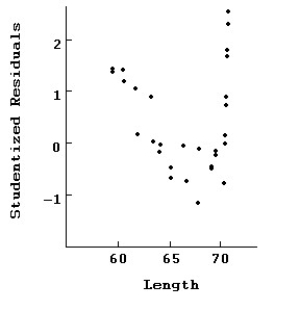Essay
Here are plots of data for Studentized residuals against Length.  Here is the same regression with all of the points at 70 removed.
Here is the same regression with all of the points at 70 removed.
Dependent variable is: Weight
30 total bears of which 10 are missing
R-squared = 97.8% R-squared (adjusted)= 97.3%
s = 2.96 with 20 - 4 = 16 degrees of freedom Compare the regression with the previous one.In particular,which model is likely to make the best prediction of weight? Which seems to fit the data better?
Correct Answer:

Verified
Omitting the values changes the coeffici...View Answer
Unlock this answer now
Get Access to more Verified Answers free of charge
Correct Answer:
Verified
View Answer
Unlock this answer now
Get Access to more Verified Answers free of charge
Q3: An actuary wishes to predict the life
Q4: How would you interpret the coefficient of
Q5: Here are plots for Studentized residuals
Q6: Here are plots of data for Studentized
Q7: The manager of a human resources
Q9: Here is the scatterplot of externally Studentized
Q10: A real estate agent wishes to predict
Q11: The manager of a human resources
Q12: What is the purpose of an indicator
Q13: The manager of a human resources